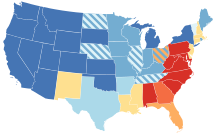Suffrage Hikes

The Suffrage Hikes (German: Wahlrechtmarsche ) between 1912 and 1914 were intended to draw the American public's attention to the demand for full women's suffrage in all states of the USA. Rosalie Gardiner Jones organized the first 13-day march from Manhattan to Albany . The organizers who marched the entire route were five women: Emma Bugbee , Ida Craft , Elisabeth Freeman , Rosalie Gardiner Jones and Lavinia Lloyd Dock .
March to Albany 1912
This march began on December 16, 1912 and headed north from a subway station in Manhattan. Of the 500 women who took part in the opening event, 200 came along for the march. After almost 14 days, the first four pilgrims arrived in Albany on December 28th.
March to Washington 1913
This march began in the Hudson Terminal in New York City on February 12, 1913 and went via Newark , Metuchen to Philadelphia and Baltimore and ended in Washington, DC on the National Mall .
Individual evidence
- ↑ Marching for the Vote , Library of Congress (English)
- ↑ Gen. Jones's Hike starts. Her Suffragist Army Will Carry a Petition to Albany. , New York Times, January 2, 1914 (English)
- ↑ a b Ida Husted Harper, Susan Brownell Anthony, Matilda Joslyn Gage: History of woman suffrage , 1922 (English)
- ↑ a b Barbara Sicherman and Carol Hurd Green (Eds.): Notable American Women: The Modern Period: a Biographical Dictionary. Belknap Press of Harvard University Press, Cambridge / Mass. 1980, ISBN 0-674-62732-6 , 197 .
- ^ Two Case Histories, Ishbel Ross and Emma Bugbee: Women Journalists Ride the Rail with the Suffragettes. , Education Resources Information Center Quote: "Bugbee walked with the suffragists on a week-long winter march from New York City to Albany"
- ↑ a b Col. Craft Is Angry. Snub For Gen. Jones. Talks of Rushing About Country at Six-Day-Bicycle-Race Speed and Says She Doesn't Like It . In: New York Times , February 25, 1913. Retrieved August 14, 2009. “So angry that she would not speak to General Rosalie Jones Colonel Ida Craft, second in command, led the detachment of suffragist hikers that spent the night at Overlea into Baltimore late this afternoon. General Jones was not in the lobby of the Hotel Stafford when Colonel Craft came tramping in. "
- ↑ a b c Col. Craft Walks On, But Hikers Protest. Her Feet Swollen So Badly That She Falls Behind Companions. Says' I Am Going Through. , New York Times, February 23, 1913
- ↑ New York Times, December 17, 1912, quoted: “Six Tired Pilgrims End First Day's Hike. But the Drum Gives Out at the Start of the Suffrage March on Albany. "
- ↑ a b Suffrage Hikers Undaunted By Cold. Plod on to Metuchen, NJ, Though One Woman Needs a Doctor When She Gets There. (PDF). In: New York Times , February 13, 1913. Retrieved July 30, 2009. “'The Army of the Hudson,' the warlike name selected for the suffragette hikers by Gen. Rosalie Jones, arrived in this town to-night after its first day's march toward Washington, where it will take part in the suffragette parade on March 3. "

